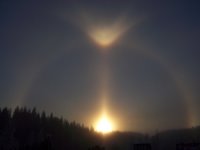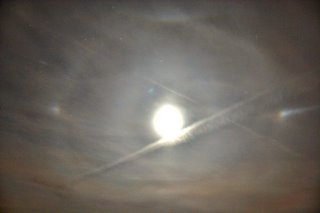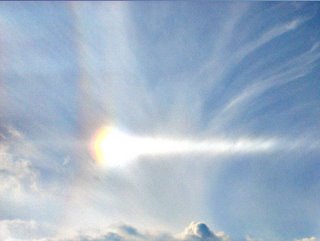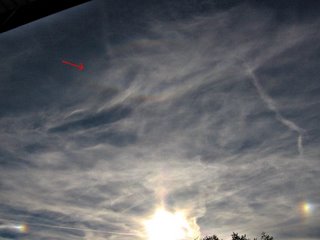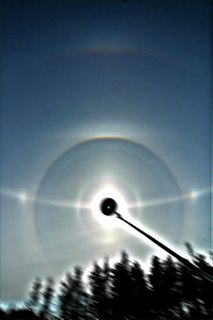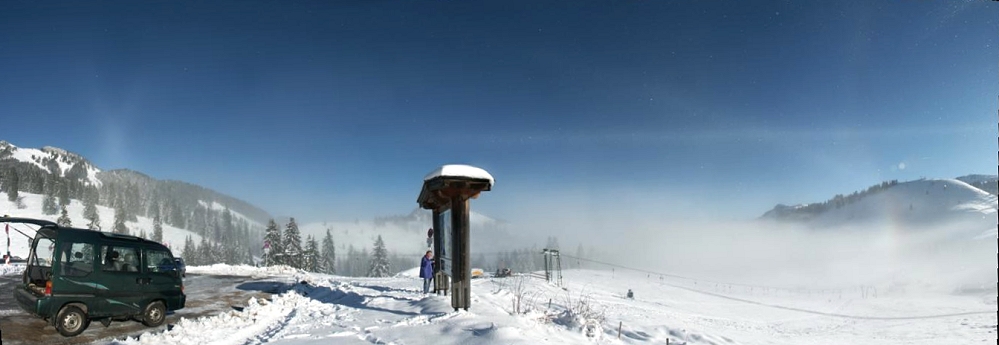 On 11th of december 2006 I saw a wonderful diamond dust phenomenon in the Wendelstein area in the altitude of ca. 1100m. It was the best in my life! I was a part of it and around me floated ice crystals with different white and coloured arcs. Directly over my head was formed an aura, the upper tangent arc I could touch and on the opposite side of the sun were some white arcs crossed in three-dimensional space.
On 11th of december 2006 I saw a wonderful diamond dust phenomenon in the Wendelstein area in the altitude of ca. 1100m. It was the best in my life! I was a part of it and around me floated ice crystals with different white and coloured arcs. Directly over my head was formed an aura, the upper tangent arc I could touch and on the opposite side of the sun were some white arcs crossed in three-dimensional space.
The origin of ice crystals were definitely natural. The clouds came from the very cold Inn valley and creeped up the mountain sattle. The sun elevation was 18 to 20 degrees.
I've seen with naked eye the following haloes: : 22° halo, upper and lower tangent arc (extremely bright!), complete sun pillar, 46°halo (very faint lower part), complete parhelic circle, anthelion, 120deg parhelia, infra- and supralateral arcs, Wegeners anthelic arc (one of the cross bows), Tricker's and diffuse anthelic arcs, heliac arc, subhelic arcs and Moilanen arc.
More pictures are here.
by Claudia Hinz
Wednesday, 13 December 2006
Diamond dust haloes in the German Alps
Wednesday, 6 December 2006
Diamond dust halos over open sea
It is not so often to see diamond dust halos over the open sea, like here in the photograph of Pasi Snellman, taken on 5 November in Porvoo, Southern Finland. The display occurred only above the sea indicating that the open water was the moisture source for ice crystal growth. A couple of of kilometers upwind from the bridge is a small ski center, and according to Snellman snow making was under way there.
Tuesday, 21 November 2006
Halo phenomena at 09/12/2006 in Mongolia
Richard Löwenherz made a cycle tour across Mongolia and while in Bajantes he witnessed a wonderful halo display. Up to 15 different types of halo (here the German halo key) were simultaneously visible. Unfortunately there are no photos because on the 10th day of the 6-week cycle tour the camera failed. However, I think, the sketch give a no less beautiful impression of the multiplicity of the kinds of halo which he could all see with the naked eye! Apart from this spectacular event, hardly any other halos were seen in Mongolia.
Monday, 13 November 2006
Lunar display in Switzerland
On Nov/11/2006 I observed a nice high moon halo display in Switzerland. Visible was a bright circumscribed halo and a infralateral or circumhorizon arc.
Wednesday, 8 November 2006
Lunar Diamond Dust Display in Pälkäne, Finland
In the evening of 4 November this lunar display graced the sky soon after sunset. Among the halo forms observed are the rare heliac arc, Tape arcs and Moilanen arc. The Moon elevation is ca. 16°.
Diamond dust display in Jämsä

In addition to photographed halos there was also something else to be seen: "I was heading east and in the north-easten sky there was as if a brighter column of fog. Probably it was part of the phenomenon", writes Simo. Most likely he was looking at a diffuse anthelic arc.
Monday, 6 November 2006
Lunar display in France with 9° halo and Lowitz arcs
On the evening of 30 October 2006, I saw this lunar display in the west of France, close to Nantes. The photos were taken between 18h and 21h UT, the moon elevation was between 19 and 24 degrees.
Diamond dust from Himos snow guns
Mika Aho was also on the halo move on Saturday 4. November. He headed for the Himos ski centre, where some 30 snow guns were operational. The trip was worthwhile. From skiing flanks spread an ice crystal cloud that, even though a bit unclean in appearance, presented some of the rarest halos.
Diamond dust from Riihivuori snow guns
Towards the last weekend tension was rising among Finnish halo observers. It was going to be clear skies with sinking temperatures and full moon. Most of the ski centers had their snow guns running, so anticipation for diamond dust was high.
Friday, 3 November 2006
Diamond dust season opened in Finland
On October 26 the pupils of the Särkijärvi school near the small northern Finland town of Muonio stopped suddenly their indoor activities and rushed out - somebody had noticed a halo wonder in the sky.
Wednesday, 1 November 2006
High sun halo display in Bolivia
Louise Emmons sent these two photos of a halo display seen on 9 October, in Noel Kempff national Park North-Eastern Bolivia. The halos are a bright circumscribed halo, a probable 46° infralateral arc and parhelic circle.
Rare halos in Czech rep. Oct. 30 and 31
On October 30 in Prague was observed rare halos. Stepanka Kosova had Lowitz arcs and 120 deg. parhelia (title photo). Lukas Shrbeny had nice 120 deg. parhelia too. I observed rare halos in two last days. On October 30 I saw: 9°, 20° halos and Parry suncave arc. On October 31 I seen: Parry suncave arc , upper and lower Lowitz arcs and probably circular Lowitz arc too. M.Popek and R.Manak seen 9° halos in Lunar displays.
Sunday, 29 October 2006
Parry sunvex and suncave arcs
Sunday, 22 October 2006
Parry and Lowitz arcs in Czech Republic

Wednesday, 18 October 2006
Circular circumscribed halo

Sunday, 15 October 2006
Lunar display with Lowitz arcs

Unidentified halo display in Romania
Attila Kosa-Kiss from Salonta, Romania observed on 29th September 2006 a very interesting halo display at a sun elevation of 12°. Unfortunately, there were no photos but there is a sketch. The most probable explanation is the existence of suncave [H] and sunvex [G] Parry arcs, as shown by the simulation from Les Cowley. Other possibilities would be an circular Lowitz arc [F], as seen on the simulation with HALOET (random: 0.5, plates: 0.5, columns: 0.5, parry: 0.5, Lowitz: 4.0, number of rays=150000). On the same day was observed several time in Germany and Czech the upper part of Lowitz arcs. But Romania was influenced by another weather front (with another cirrus clouds) like the middle European area. Further comments and ideas are very welcome!
Saturday, 14 October 2006
Tricker arc in Prague
Czechoslovakia Lowitz arcs
Thursday, 12 October 2006
Circular Lowitz arc in Germany
More rare halos in Czechoslovakia
Tuesday, 10 October 2006
Lowitz arc in Prague
Sunday, 8 October 2006
9° column arcs in Prague
Wednesday, 4 October 2006
Lower Parry arc in Antarctica region
Monday, 2 October 2006
Low sun Parry in Helsinki
Friday, 29 September 2006
Wegener arcs in Czechoslovakia again

Sunday, 24 September 2006
From archives: odd radius column arcs in 2001

By Marko Riikonen
Monday, 18 September 2006
Lowitz arcs in Czech
 Martin Popek observed this display with Lowitz acrs on 16. September. Interesting feature is the lower Lowitz component extension above parhelion. In the simulation there is something like that, but it's very, very ghostly. The main body of the lower component below parhelion looks as if it were just a patch of 22° halo - the extension towards parhelion is missing. Same goes with the upper component. This is quite typical way of Lowitz arcs showing up. Circular component is seen only above parhelion.
Martin Popek observed this display with Lowitz acrs on 16. September. Interesting feature is the lower Lowitz component extension above parhelion. In the simulation there is something like that, but it's very, very ghostly. The main body of the lower component below parhelion looks as if it were just a patch of 22° halo - the extension towards parhelion is missing. Same goes with the upper component. This is quite typical way of Lowitz arcs showing up. Circular component is seen only above parhelion.
I was given sun elevation of 39° for this display but somewhat lower elevation gave a bit better simulation results. This is for 33°. The projection in the simulation is clearly not the same as in camera and this may have caused some of the broblems. Simulation is made with Halosim by Les Cowley and Michael Schroeder.
Be the sun elevation 39° or 33°, it does not change much anything fundamentally. Several question could be raised about this display with lenghty discussions. It seems we still have a long way to understanding Lowitz arcs.
By Marko Riikonen
V-shaped Parry and Tape's arc in Germany
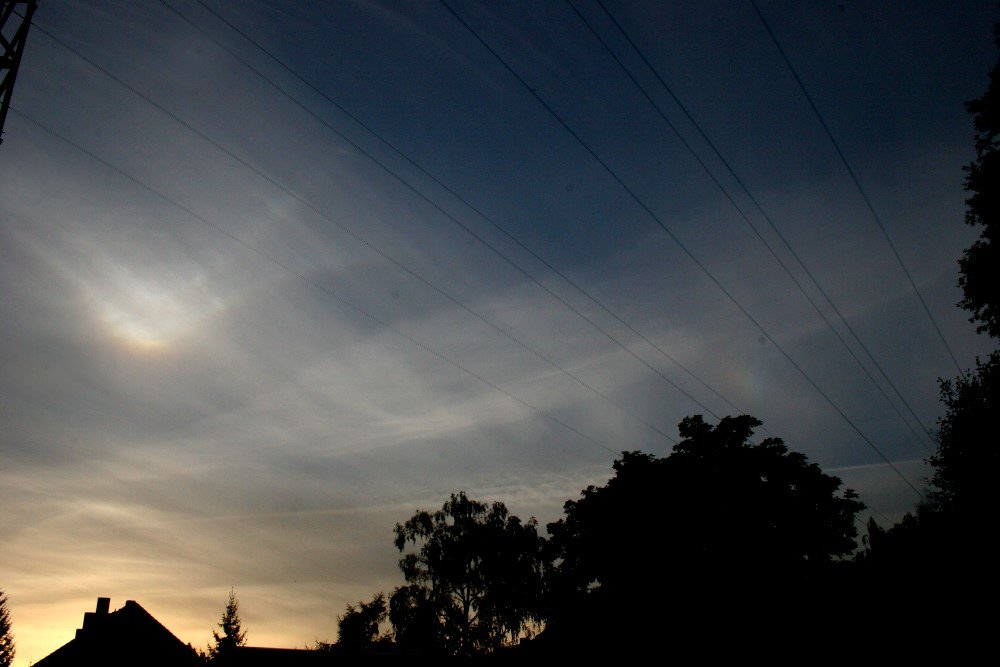 On August 31, 2006, clouds moved in destroying all hopes for meteor observations in the night. The halo display in the high clouds close to sunset (1725 UT, Sun elevation approximately 3 deg) observed by Jürgen Rendtel from Marquardt (west of Berlin, 13.0 deg E, 52.5 deg N) included intense V-shaped upper tangent and Parry arcs. Another bright coloured 'spot' of about 3 deg apparent size was found to be part of the supralateral arc and Tape's halo. The image processing by Claudia Hinz using unsharp masking also revealed the convex Parry arc.
On August 31, 2006, clouds moved in destroying all hopes for meteor observations in the night. The halo display in the high clouds close to sunset (1725 UT, Sun elevation approximately 3 deg) observed by Jürgen Rendtel from Marquardt (west of Berlin, 13.0 deg E, 52.5 deg N) included intense V-shaped upper tangent and Parry arcs. Another bright coloured 'spot' of about 3 deg apparent size was found to be part of the supralateral arc and Tape's halo. The image processing by Claudia Hinz using unsharp masking also revealed the convex Parry arc.By Claudia Hinz
Saturday, 16 September 2006
Circumscribed halo and pyramid halos in Sardinia
Thursday, 14 September 2006
A fine circumhorizontal arc from Italy

Circumhorizontal arc more than 100° wide above the horizon, very brilliant, for about 25 minutes. The best I have seen from Italy!
By Paolo Candy
Saturday, 9 September 2006
Odd radii in Czech Republic
By Marko Riikonen
Wednesday, 16 August 2006
HOP meeting 13 - 16 August 2006

Monday, 14 August 2006
Subhorizon diffuse arcs with Liljequist subparhelia
Francesco De Comité took this great photo from an airplane between Brussels and Madrid in 7 August 2006 at 19h31. Unfortunately no more additional photos are available from this display.
Sunday, 23 July 2006
Subparhelic circle
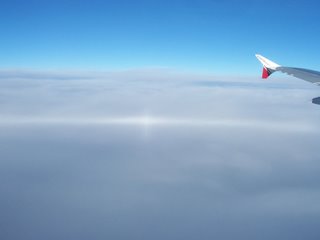
Monday, 17 July 2006
Halo Meeting in Finland 14-16 July 2006
Friday, 9 June 2006
Wegener anthelic arcs in Ondrejov
By Patrik Trncak
Friday, 19 May 2006
World database of rare halos
For all rare halos of the world is database now. The most contribution to database is from Finnish, Czech and German observing networks, and from a couple of active observers from USA. You can search the database in four ways: all observations, name of observer, country of observation and name of halo.
Bottlinger's Rings from airplane
To help overcome our dearth of halos, here is another archive picture. It was taken in the morning over Iberian Peninsula in April 1997 by Frank Wächter using a 35mm lens. It shows elliptical haloes around the subsun called Bottlinger's rings.
Thursday, 18 May 2006
A halo caused by light reflected from water surface
The best sun pillars are usually seen in the icy virga of the Altocumulus clouds. This is because virga can consist of very big plate crystals that have plenty of horizontal surface to reflect sun light. Thus it would be expected that if this phenomenon were to occur, it would be Ac virga if anything. In high clouds it's impossible to see this, becase there is nothing behind the crystals to block the Sun. And when diamond dust occurs, waters are usually frozen. Thus ice crystals precipitating from middle level clouds is perhaps the only possible formation for the phenomenon Holopainen photographed. In yet another photo taken by Holopainen, a curved Ac virga can be seen in the middle of the picture above the lake. This is the lake that most likely was responsible for the reflection.
Monday, 15 May 2006
Odd radius plate arcs

Saturday, 13 May 2006
Doubled Halos?
Wednesday, 10 May 2006
Unknown halo in Germany
Lower 23 degree plate arc observed in Ohio USA 5-9-06
Sunday, 7 May 2006
Odd radius halos in Finland
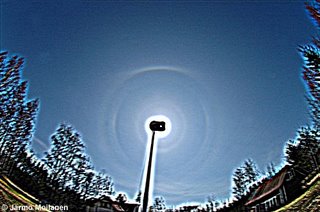
Wednesday, 3 May 2006
Ice Crystals






